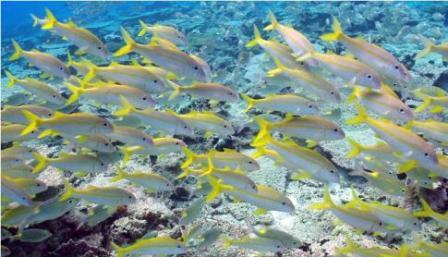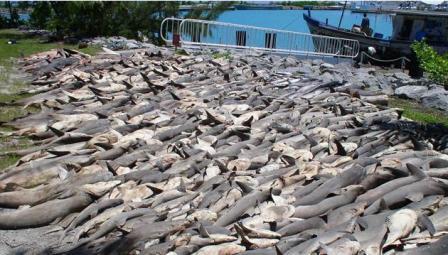The oceans are becoming increasingly depleted due to overfishing, pollution and climate change, they can only be rescued by a vast global marine conservation campaign, scientists said. know July 30.

Mulloidichthys vanicolensis yellow fin alum fish.
The oceans cover more than 70% of the earth's surface.However, only over 1% of the surface of the oceans is protected and most important marine reserves are only protected at a limited level.
According to the analysis of Professor Callum Roberts - one of the participants in the leading ocean protection campaign, working at York University, Canada - on the blue planet only about 0.1% of the surface of the oceans is fully protected from all exploitation.
Facing this situation, ' Global Ocean Legacy ' (The Global Ocean Legacy, GOL) - a project of the Pew Environment Group (The Pew Environment Group, currently based in the United States, Canada, Europe, Australia) New Zealand, Western Pacific and Indian Ocean were signed with a joint agreement between 257 marine science experts from 37 countries around the world to establish a more coastal protection network. more globally.
Professor Roberts told CNN: 'We have strong and strong evidence that the ocean ecosystem is under threat and that they need protection . '
'Today, fishing is happening in every corner of the ocean and climate change is two of the causes that endanger the marine life. The only way to save them is to establish more marine protected areas . '

Shark poaching is one of the most serious problems
at Chagos Islands Conservation Area.
According to Greenpeace, up to 90% of the ocean's vast reserves of predatory fish have disappeared and 90% of fish stocks have been caught in the area of European Union countries. (EU).
David Ritter, a leading researcher on biodiversity at Greenpeace in the UK, told CNN: 'Undoubtedly, the oceans are in crisis. We found a systematic decline of the marine environment everywhere. Unintentional fishing has reduced global fish production by 80% . '
'The fish stocks are being depleted, especially the highest predatory fish in the ocean food chain such as sharks, tuna and swordfish. Currently, there are many small fish and crustaceans that dominate some of the seas because their enemies have been destroyed by humans, gradually these species will also disappear if the unspoiled exploitation is not possible. prevent, and a disastrous end can happen to the situation that the oceans only have sea worms left , 'Mr. Ritter worried.
The Pew Environment Group has planned a five-year GOL project, which was launched in 2007 with the aim of persuading governments to establish four very large Marine Protected Areas, the Marine Protected Area. off the northeastern coast of Australia (1,061,895 km2), the Marine Protected Area surrounds the Kermadec Islands, near New Zealand (637,137 km2), the gulf (area) of Mariana - the deepest trench in the world in the US and Pacific waters. and Marine Protected Area surrounds the Chagos Islands, the Indian Ocean (544,000 km2).

is home to more than 1,000 species of fish.
So far, the establishment of two of the four protected areas of the project that have been successful are the Mariana Trench and the Chagos Islands, the other two protected areas are being urgently established.In April 2010, the Chagos Islands were protected by the UK Government, becoming the world's largest marine reserve today.
Mr. Jay Nelson, project manager of GOL said: 'Marine reserves are relatively easy to establish in the sovereignty waters, because governments can act unilaterally. However, it will be more complicated for international waters by requiring supervision and cooperation between countries. Monitoring and enforcement of law in international waters is particularly difficult . '
Nelson said: 'The 93,240 square kilometer marine protected area was established last year in international waters around the South Ocean's South Orkney Islands (the Antarctic Peninsula) to achieve good results. and it is currently being implemented for other waters in the world . '
Here are the colorful and unique images under the sea surrounding the Chagos Islands, the Indian Ocean.(Photo: Catriona Davies / CNN)



The species of Carcharhinus longimanus shark.





Carcharhinus amblyrhychos gray shark.
 Animal 'suffering' after hibernation
Animal 'suffering' after hibernation Why do goats climb well?
Why do goats climb well? Scientists were surprised to see chimpanzees eating turtles
Scientists were surprised to see chimpanzees eating turtles Giant catfish died deadly due to drought in Thailand
Giant catfish died deadly due to drought in Thailand